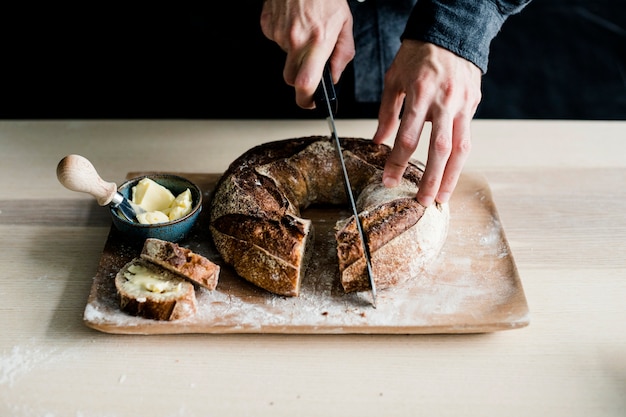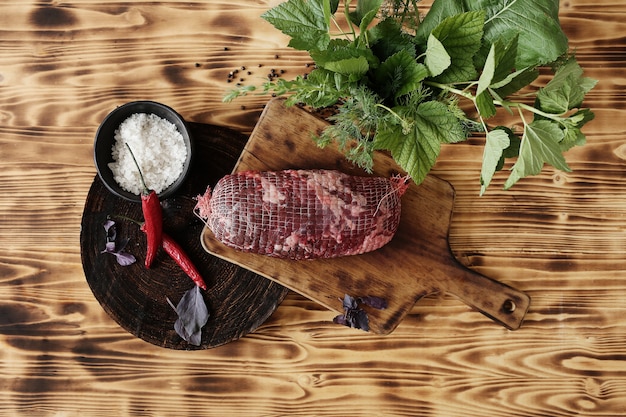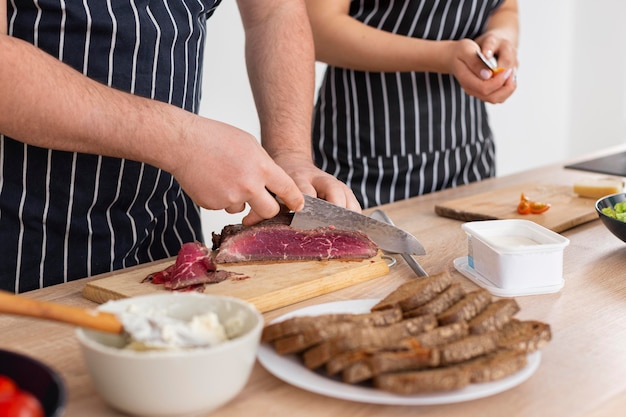(Part 1) Getting Started: Choosing Your Prime Rib

Prime Rib Cuts: A Closer Look
You’ll find a few different cuts of prime rib available, but the most common ones are: Standing rib roast: This is the classic, traditional choice, featuring the bone-in rib section. It’s usually around 3-4 ribs long and can weigh anywhere from 4 to 8 pounds, making it a perfect option for larger gatherings. It’s like the rockstar of prime ribs – it’s got that iconic look and flavour. Rib Roast: This cut is similar to the standing rib roast, but the bone has been removed. It’s typically a bit smaller, weighing around 3-6 pounds. This makes it a great option for smaller gatherings or if you prefer a more evenly cooked roast. English Roast: This is the heavyweight champion, a larger, more impressive cut, often referred to as a "rolled" prime rib. It's comprised of three or more ribs, with the bone removed and the meat rolled and tied, giving it a beautiful, elegant shape.Tips for Picking the perfect prime rib
- Size: Consider how many people you’re serving. A good rule of thumb is to allow about 1 pound of prime rib per person. You don’t want to run out or have too much left over!
- Marbling: This is where the flavour magic happens. The more marbling (the streaks of fat) a prime rib has, the more flavourful and tender it will be. Look for cuts with good marbling throughout – you want that rich, buttery flavour.
- Bone-in or Boneless? Both have their pros and cons. Bone-in ribs offer a more traditional flavour and retain moisture, but boneless roasts cook more evenly. It comes down to personal preference and what you’re looking for in your roast.
(Part 2) Prepping the Prime Rib: Setting the Stage for a Perfect Roast

Seasoning Perfection: A Flavor Symphony
Now, I’m a big believer in simplicity when it comes to seasoning. You don’t need a fancy blend of spices to elevate the prime rib’s natural flavour. Let the meat be the star of the show, with just a few key players to enhance its natural deliciousness.Here’s my go-to seasoning mix, a recipe for flavour success:
- Salt: Kosher salt is my preference, as it dissolves more evenly than table salt. Don’t be shy – season generously!
- Black Pepper: Freshly ground black pepper adds a beautiful aroma and depth of flavour. It’s like adding a touch of magic to your roast!
- Garlic Powder: A touch of garlic powder enhances the natural flavours of the meat. It’s a subtle but powerful addition.
- Optional: If you want a bit more kick, you can add a sprinkle of paprika, onion powder, or dried rosemary. These additions add a touch of warmth and complexity to your seasoning.
Remember, the key is to season evenly, coating the entire surface of the prime rib. This ensures that every bite is bursting with flavour.
A Little Rest Makes a Difference
After seasoning your prime rib, don’t rush into the oven! Give it a good rest in the refrigerator for at least 2 hours, or even better, overnight. This is where the magic of patience comes in. It allows the flavours to meld and penetrate the meat, resulting in a truly unforgettable taste. It’s like letting a good wine breathe – it takes time to unleash its full potential!(Part 3) The Low and Slow Method: Cooking at 250 Degrees

The Slow and Steady Approach
Here’s the deal: slow-roasting at 250 degrees is about patience. It takes longer than other cooking methods, but it’s the secret to juicy, melt-in-your-mouth meat. The low temperature allows the fat to render slowly, creating incredible flavour and keeping the meat tender. Think of it like a slow-cooked stew – the longer you cook it, the more flavourful and tender it becomes.Timing is Everything: The Prime Rib Clock
Alright, let's talk about timing. It's a bit of a guessing game, but here's a general guide based on the weight of your prime rib:| Weight (pounds) | Cooking Time (hours) |
|---|---|
| 4-5 pounds | 2.5-3 hours |
| 6-7 pounds | 3-3.5 hours |
| 8-9 pounds | 3.5-4 hours |
These are just estimates, and cooking time can vary depending on your oven and the thickness of the roast. Don't worry, we'll talk about how to check for doneness later. It’s all about getting a feel for it – and don’t be afraid to adjust your time based on your specific roast.
(Part 4) The Art of Roasting: Oven Essentials
Time to get the oven ready and fire up your prime rib! This is where you’ll be setting the stage for the perfect roast.Oven Setup: The Ideal Roasting Environment
Preheat your oven to 250 degrees Fahrenheit. It's important to start with a consistently heated oven to ensure even cooking. Use a roasting pan that's large enough to accommodate the prime rib comfortably. You want the roast to have enough space to cook evenly without touching the sides of the pan. If you’re using a standing rib roast, a roasting rack is essential for allowing air to circulate around the meat, ensuring even cooking. This is like giving your roast a little spa treatment, so it cooks perfectly from all sides.Roasting Technique: The Secret to Success
Place the seasoned prime rib in the roasting pan. If you’re using a rack, make sure the roast sits evenly on it. Roast the prime rib for the estimated time, ensuring it’s uncovered. This allows the moisture to escape and the surface to crisp up beautifully. This creates that delicious, crispy crust that we all love.(Part 5) Resting Time: Let the Prime Rib Relax
After roasting, it’s time to let the prime rib relax and settle. This allows the juices to redistribute throughout the meat, resulting in a tender and flavorful roast. This is the final stage before you get to enjoy the fruits of your labour!The Importance of Rest
Don’t rush into carving! Let the prime rib rest for at least 15-20 minutes, preferably covered with foil. During this time, the internal temperature will continue to rise, and the juices will re-absorb, ensuring a more tender and flavorful cut. It’s like giving your roast a little post-workout recovery – it makes all the difference.(Part 6) Checking for Doneness: The Perfect Prime Rib
Now, the moment of truth: how do you know when your prime rib is cooked to perfection?meat thermometer: Your Culinary Hero
The most accurate way to check for doneness is to use a meat thermometer. Insert it into the thickest part of the roast, avoiding the bone. This is like peeking inside to see if your roast is ready. For medium-rare: Aim for an internal temperature of 130-135 degrees Fahrenheit. This is when the meat is still slightly pink in the centre and incredibly juicy. For medium: Aim for an internal temperature of 140-145 degrees Fahrenheit. This is when the meat has a bit more brown in the centre and is still very tender. For medium-well: Aim for an internal temperature of 150-155 degrees Fahrenheit. This is when the meat is more well-done and has a bit more of a brown colour throughout.Other Indicators: Doneness Clues
Color: When the prime rib reaches the desired internal temperature, the meat should have a slight reddish-brown color, indicating it’s cooked through but still juicy. Touch: Press gently on the roast. The meat should spring back slightly, indicating it’s cooked. This is a good way to get a sense of the texture of the meat.(Part 7) Carving and Serving: The Grand Finale
Now comes the exciting part: carving your perfectly roasted prime rib. This is the moment you’ve been waiting for – it’s time to enjoy the fruits of your labour!Carving Techniques: Master the Art
Use a sharp carving knife and a sturdy cutting board. This is important for clean, precise cuts. cut across the grain of the meat to create thin, tender slices. Cutting with the grain will result in tougher slices. Be patient and take your time. This is a moment to enjoy and savour, not rush.Serving Style: Elevate the Experience
Arrange the carved prime rib slices on a platter. Offer a variety of side dishes to complement the roast, such as roasted vegetables, mashed potatoes, or Yorkshire pudding. These dishes add a touch of flavour and visual appeal to your feast. Don’t forget the gravy! A rich, flavorful gravy is the perfect accompaniment to your prime rib.(Part 8) FAQs: Your Prime Rib Questions Answered
Let's tackle some of the common questions you might have about slow-roasting prime rib at 250 degrees. I’ve been there, so let’s clear up any doubts you might have!1. Can I roast prime rib at 250 Degrees in a slow cooker?
While you can cook prime rib in a slow cooker, it's not the ideal method for achieving the perfect roast. Slow cookers tend to cook at lower temperatures, which can make the meat tough and dry. It’s best to stick to the oven for this method.2. What if My Oven Temperature Fluctuates?
Oven temperatures can vary. If you find your oven is running a little hot or cold, adjust the cooking time accordingly. Use a meat thermometer to check for doneness, and don’t hesitate to adjust the time as needed.3. Can I Marinate the Prime Rib Before Roasting?
Yes, marinating prime rib can enhance its flavour. A simple marinade of olive oil, salt, pepper, garlic, and herbs can be used. Let the prime rib marinate in the refrigerator for at least 4 hours or overnight. This allows the flavours to penetrate the meat and create a deeper, more complex taste.4. Can I Cook Prime Rib at 250 Degrees in a Gas Grill?
Yes, you can cook prime rib at 250 degrees on a gas grill. Use indirect heat and maintain a consistent temperature. You may need to adjust the cooking time slightly based on your grill. This is a great option for those who want to add a smoky flavour to their prime rib.5. What Happens if I Overcook the Prime Rib?
Overcooked prime rib will be dry and tough. If this happens, it's best to slice the meat thinly and serve it with a rich sauce or gravy to compensate for the dryness. This helps to add moisture and flavour to the meat.Final Thoughts: The Journey of a Prime Rib
So there you have it, a comprehensive guide to slow-roasting prime rib at 250 degrees. It’s a method that demands patience, but it rewards you with a truly unforgettable culinary experience. You’ve got this! Remember, cooking is a journey, not a race. Embrace the process, experiment with different seasonings, and enjoy the satisfaction of creating a feast that will leave your guests raving. Happy roasting!Everyone is watching

How to Cook Frozen Lobster Tails Perfectly: A Step-by-Step Guide
RecipesLobster. Just the word conjures up images of lavish meals, special occasions, and a taste of luxury. But let's...

Pigs in a Blanket Cooking Time: How Long to Bake for Perfect Results
RecipesAh, pigs in a blanket. Just the name conjures up images of those delightful little parcels of crispy pastry en...

Pork Fillet Cooking Time: How Long to Cook It Perfectly
RecipesPork fillet, or tenderloin as it's sometimes called, is a real favourite in our house. It's so versatile, and...

The Ultimate Guide to Tender, Juicy Pulled Pork
RecipesRight, let's talk pulled pork. It's one of those dishes that just screams "comfort food," doesn't it? I mean...

The Ultimate Guide to Cooking Sweet Potatoes: From Roasting to Mashing
RecipesSweet potatoes. Just the name conjures up images of warm, comforting dishes, bursts of vibrant color, and a to...
